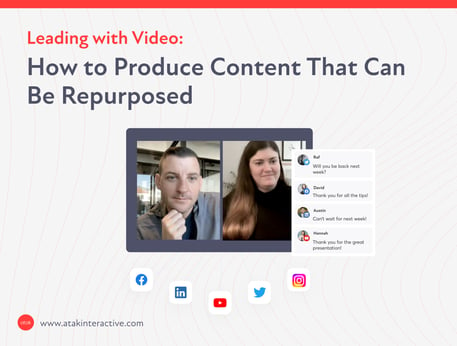Leading with Video: How to Produce Content that Can Be Repurposed
Leading with Video: How to Produce Content that Can Be Repurposed
You just spent two hours writing a 2,000-word blog post. It's thoughtful. It's polished. It answers real questions your buyers are asking.
And now you need to promote it. So you write a LinkedIn post. Then a Twitter thread. Then you record a quick video summary. Then you realize you should probably make some graphics for Instagram.
Four hours later, you've created one asset that exists in five different formats—and you're exhausted.
Here's the better way: Start with video. One 10-minute conversation becomes a blog post, YouTube content, LinkedIn posts, Instagram Reels, TikTok shorts, podcast audio, and email newsletter content. All from one recording session.
This isn't theory. This is how modern content teams scale without burning out. And if you're still leading with text, you're working twice as hard for half the visibility.
Let's talk about why video-first content strategies work, how to repurpose one video into a dozen assets, and what you actually need to get started (spoiler: it's not a fancy studio).
Why Video Should Be Your Content Foundation
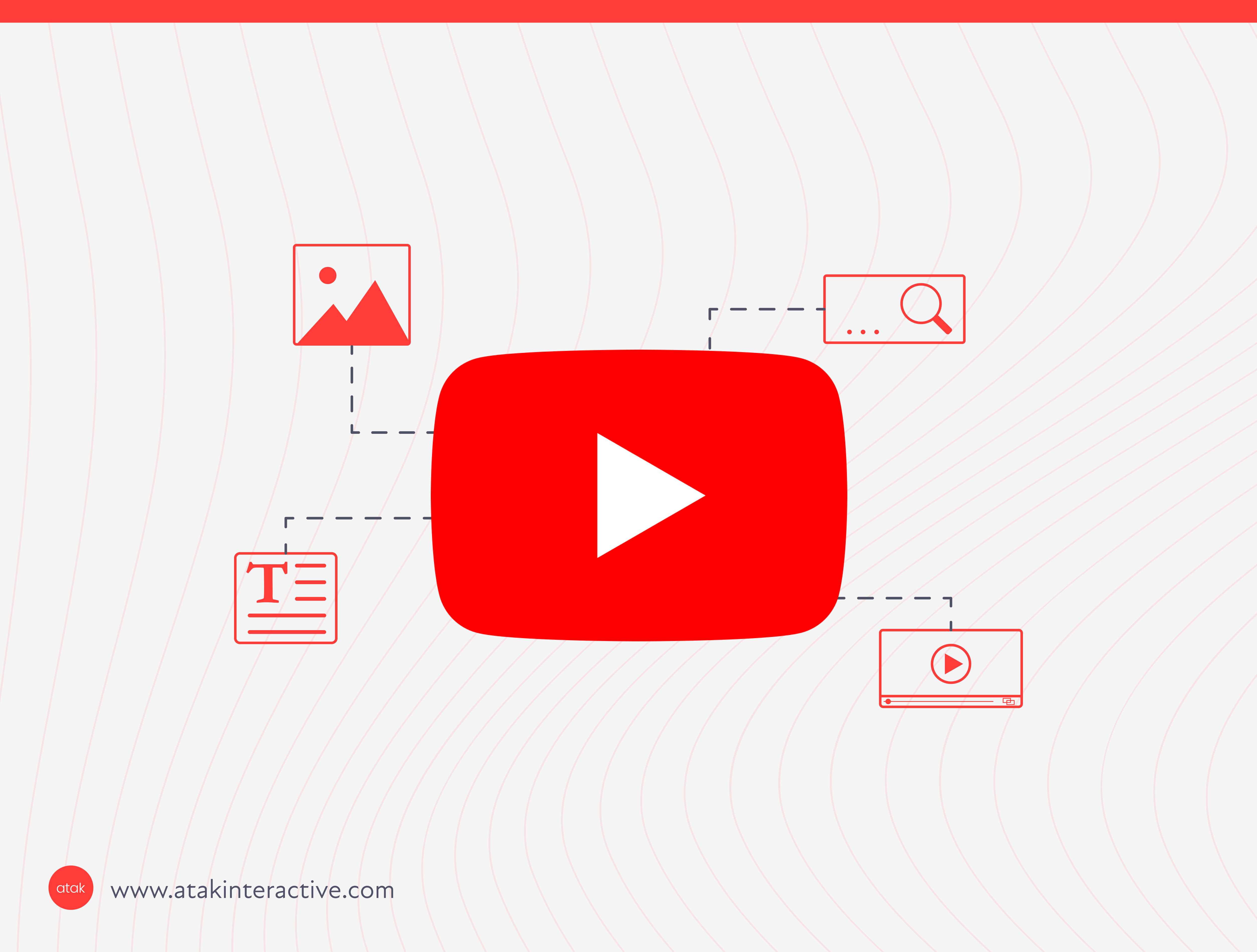
Let's be honest: writing is harder than talking.
You sit down to write a blog post and suddenly you're agonizing over every sentence. Should this paragraph go here or there? Is this too casual? Too formal? Does this transition make sense?
Writing takes time. Writing takes mental energy. And for most people, writing feels like pulling teeth.
But talking? Talking is easy.
You already know your subject. You've explained it to clients a hundred times. You can riff on it for 10 minutes without breaking a sweat.
So why are you forcing yourself to write when you could just hit record and talk?
Here's what happens when you lead with video:
- Content production speeds up dramatically. A 10-minute video takes 10 minutes to record. Transcribe it, clean it up, and you have a 1,500-word blog post in under an hour.
- You capture your authentic voice. Video preserves the way you actually explain things—the examples you use, the metaphors that click, the personality that makes people trust you.
- You create multiple assets at once. One video becomes a YouTube upload, a blog post, LinkedIn clips, Instagram Reels, TikTok content, podcast audio, and email snippets. You're not creating one piece of content—you're creating the raw material for ten.
- You show your face. People buy from people. Video lets prospects see who you are before they ever talk to sales. That builds trust faster than any whitepaper.
The companies dominating content right now aren't writing more. They're recording more and repurposing smarter.
The YouTube Advantage: SEO's Best-Kept Secret
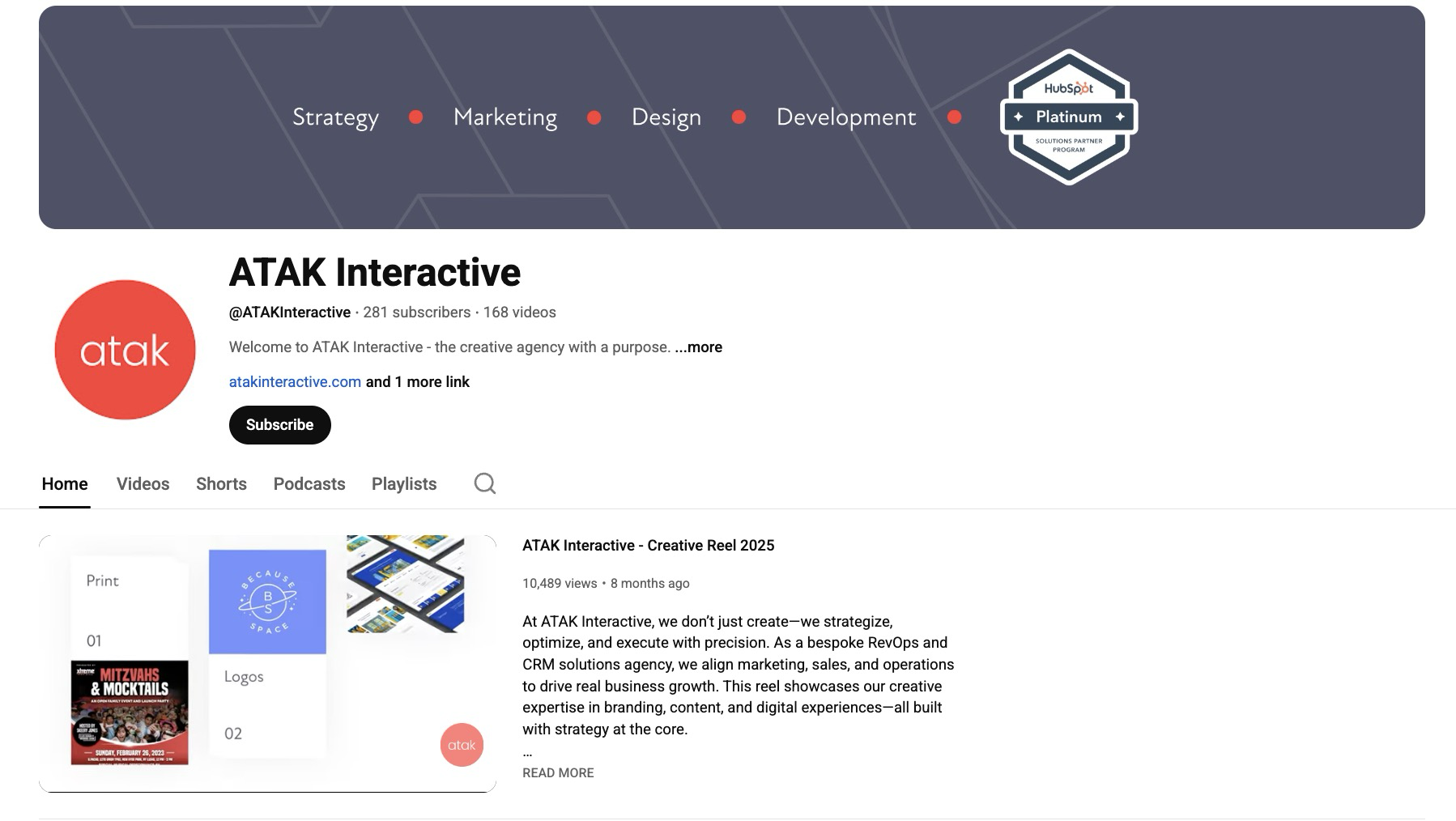
If Google is the king of search, YouTube is the prince.
YouTube is the second-largest search engine in the world. It's owned by Google. And Google prioritizes YouTube content in search results.
Translation: Publishing on YouTube gives you two chances to get found—once on YouTube, once on Google.
Here's what most companies miss: YouTube videos rank in Google search results. When someone searches "how to integrate HubSpot and Salesforce," Google shows YouTube videos alongside blog posts. If you have both, you're taking up more real estate in search results.
But there's more:
- YouTube transcripts feed AI platforms. ChatGPT, Perplexity, and Claude can parse YouTube transcripts. If your video content is structured well, AI platforms can cite it.
- Video watch time signals authority. Google looks at engagement metrics. Videos with high watch time signal that your content is valuable, which boosts your overall domain authority.
- YouTube shorts hit discovery algorithms. Short-form video (under 60 seconds) gets pushed to new audiences through YouTube Shorts, TikTok, Instagram Reels, and LinkedIn. One video can reach people who would never find your blog.
And here's the kicker: YouTube content compounds over time. A blog post might get traffic for a few months. A YouTube video can drive views for years.
If you're serious about search visibility, YouTube isn't optional. It's infrastructure.
From One Video to Ten Assets: The Repurposing Framework
You record one 10-minute video. Here's what you do with it:
- Upload to YouTube (full video)
- Optimize title, description, and tags for search
- Add a full transcript (for accessibility and SEO)
- Create a custom thumbnail
- Add timestamps to key sections
- Create YouTube Shorts (5-10 clips)
- Use tools like Streamyard or Opus Clip to auto-generate short clips
- Pull out the best 30-60 second moments
- Add captions and upload as Shorts
- Transcribe and turn into a blog post
- Run the video through a transcription tool (Otter, Descript, or AI)
- Clean up the transcript, add structure (headers, bullets)
- Publish as a long-form blog post with embedded video
- Add schema markup for SEO
- Post full video to LinkedIn
- Native video uploads get more engagement than links
- Write a strong hook in the caption
- Tag relevant people or companies
- Clip for Instagram Reels and TikTok
- Vertical format (9:16)
- Add captions (80% of people watch without sound)
- Use trending audio if relevant
- Pull key quotes for social posts
- Grab 3-5 key insights from the transcript
- Turn each into a standalone LinkedIn or Twitter post
- Link back to the full video
- Extract audio for podcast distribution
- Upload audio-only version to podcast platforms
- Expands reach to listeners who don't watch video
- Repurpose into email content
- Use key insights as newsletter topics
- Link to the full video for deeper dives
- Create graphics or quote cards
- Pull out quotable moments
- Design simple graphics for social sharing
- Update older content with video embeds
- Do you have an existing blog on this topic? Embed the video
- Refresh the publish date and re-promote
Result: One 10-minute recording session becomes 10+ pieces of content, all working together to build visibility across platforms.
This is how you scale content without scaling headcount.
What You Actually Need to Start (Hint: Not Much)
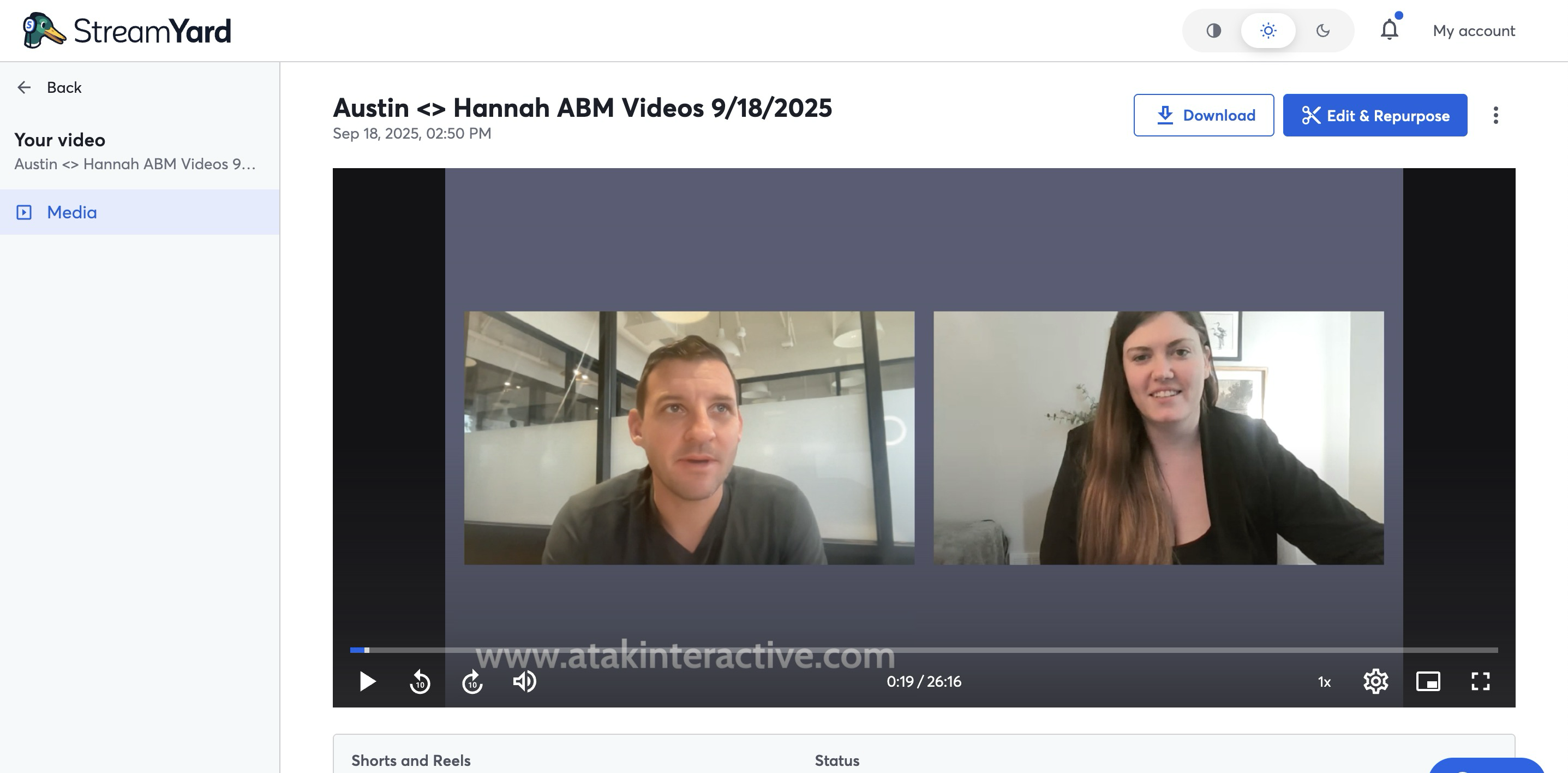
The biggest barrier to video content isn't talent or skill. It's the belief that you need expensive equipment and a professional setup.
You don't.
Here's what actually matters:
- A phone or webcam. Your iPhone records in 4K. That's good enough. Webcams work fine for talking-head content. You don't need a RED camera.
- Decent lighting. Sit near a window. Natural light is free and looks great. If you're recording at night, get a $30 ring light on Amazon.
- Clear audio. Bad audio kills videos. Invest in a $50 USB microphone (Blue Yeti, Samson Q2U) or use wired earbuds. Audio matters more than video quality.
- A simple recording setup. Streamyard, Zoom, or Riverside.fm all work. You don't need editing software to start. Record, download, upload.
- A topic you care about. This is the most important part. If you're passionate about the subject, it shows. If you're just reading a script, people tune out.
What you don't need:
- A studio
- Professional lighting rigs
- A teleprompter
- A script
- Multiple takes (usually)
The less polished your video looks, the more authentic it feels. People don't want perfection. They want real expertise delivered in a way they can relate to.
Authenticity Beats Production Value Every Single Time
Here's a truth that makes video producers mad: low-production videos often perform better than high-production ones.
Why? Because people trust authenticity more than polish.
A guy recording on his phone in his car explaining a complex topic clearly will get more engagement than a perfectly lit, professionally edited video that feels like a commercial.
What audiences respond to:
- Real expertise, not rehearsed talking points
- Conversational tone, not corporate speak
- Genuine passion for the subject
- Natural delivery, not scripted perfection
Example: Gary Vaynerchuk built an empire on vertical phone videos. Alex Hormozi films most of his content on an iPhone. Ali Abdaal started with a webcam in his dorm room.
None of them waited for perfect equipment. They started with what they had and let the content do the work.
Your job isn't to be a filmmaker. Your job is to share what you know in a way that helps people.
If you wait until your setup is perfect, you'll never start. And the companies that start now—even with imperfect videos—will be miles ahead of you in six months.
Diversifying Your Video Formats to Keep Content Fresh
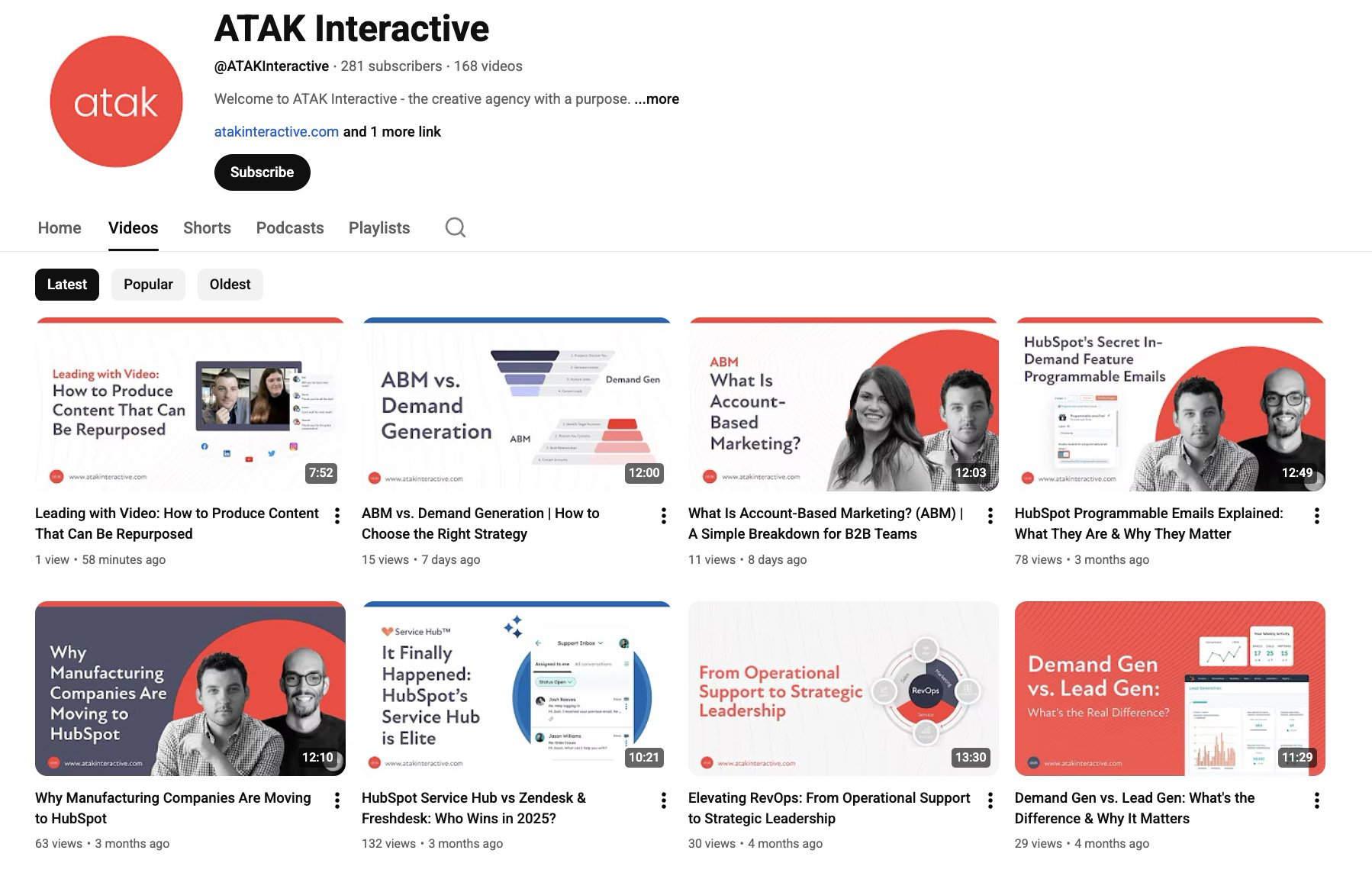
If you're thinking "I can't just sit and talk to a camera forever," you're right. That format gets stale.
Here are different video formats you can rotate through:
- Solo talking-head videos
- You + camera + topic
- Best for: thought leadership, opinions, explanations
- Two-person dialogues
- Interview format or co-host conversation
- Best for: debates, Q&A, diverse perspectives
- Roundtable discussions
- 3-5 people discussing a topic
- Best for: complex topics that benefit from multiple viewpoints
- Screen recordings
- Walk through a process, demo a tool, show data
- Best for: tutorials, software demos, analytics breakdowns
- Behind-the-scenes
- Show how your company works, office culture, project updates
- Best for: humanizing your brand, building connection
- Customer stories
- Interview clients about their results
- Best for: social proof, case studies, testimonials
- Man-on-the-street style
- Record while walking, driving, or in different locations
- Best for: quick takes, off-the-cuff insights
- Live streams
- Real-time interaction with audience
- Best for: Q&A, product launches, community building
Mix these formats to keep content interesting. One week you're solo. Next week you interview a client. The week after, you do a roundtable with your team.
Variety keeps you engaged as a creator and keeps your audience interested.
The First Video Is Always the Worst (And That's Okay)
Here's what stops most people from starting: they're terrified of being on camera.
You're worried you'll sound stupid. You'll stumble over words. You'll hate how you look. You'll cringe watching it back.
All of that is true. And all of that is fine.
Your first video will be awkward. Your second will be slightly less awkward. By your tenth, you'll feel comfortable. By your fiftieth, you'll be a natural.
Everyone who's great on camera started by being terrible on camera.
The only way through the discomfort is to do it. Record a video. Don't overthink it. Don't watch it back 20 times. Just publish it.
Pro tip: You don't even have to use your first video. Record it as practice. Delete it if you want. But get the nerves out so your second video is easier.
The barrier isn't skill. The barrier is starting. And once you start, momentum takes over.
If you're waiting to feel ready, you'll wait forever. Just record something today.
How Video Fits Into Modern Search Strategy
We've talked about why video matters for content velocity and authenticity. But here's the bigger reason: video is essential for modern search visibility.
Here's how video content impacts your search presence:
- YouTube is the second-largest search engine. Your buyers are searching there. If you're not, your competitors are.
- Google prioritizes video in search results. Video results appear in Google search. If you have a video on a topic, you're more likely to rank.
- AI platforms parse YouTube transcripts. ChatGPT, Perplexity, and Claude can pull information from YouTube videos. Transcripts make your content machine-readable.
- Video watch time signals authority. High engagement on video content tells Google your brand is trustworthy, which lifts your entire domain's performance.
- Video clips drive social discovery. YouTube Shorts, TikTok, Instagram Reels—all of these push your content to new audiences who would never find your blog.
- Video builds brand recognition. People remember faces. When prospects finally reach your website, they already feel like they know you.
Video isn't just content. It's a distribution strategy, a search strategy, and a trust-building strategy all in one.
If you're serious about visibility, video has to be part of the mix.
Building a Sustainable Video Content Engine
You don't need to publish daily. You don't need to become a full-time YouTuber.
Here's a realistic cadence that works:
Weekly or bi-weekly long-form videos (8-15 minutes)
- Deep dives on important topics
- Interviews or roundtables
- Tutorial or explainer content
Daily or near-daily short-form clips
- Repurposed from long-form content
- Quick takes on trending topics
- Pulled from internal meetings or calls
Here's what this looks like in practice:
Week 1:
- Record one 10-minute video on Monday
- Editor creates 5-10 short clips by Wednesday
- Blog post published by Thursday
- Clips distributed across LinkedIn, Instagram, TikTok all week
Week 2:
- Record one interview with a client or partner
- Same repurposing process
Week 3:
- Record a solo thought leadership video
- Same process
Week 4:
- Record a screen-share tutorial
- Same process
Result: 4 long-form videos and 20-40 short clips per month, all from 4 recording sessions.
That's sustainable. That's scalable. And that's more content than 90% of your competitors are publishing.
Stop Overthinking and Start Recording
You don't need a studio. You don't need a teleprompter. You don't need a script.
You need:
- A camera (your phone works)
- A microphone (even AirPods are fine to start)
- A topic you care about
- 10 minutes of your time
Record the video. Upload it to YouTube. Transcribe it. Turn it into a blog post. Clip it for social. Repeat.
That's the entire playbook.
The companies winning at content right now aren't smarter than you. They're not more talented. They're not working harder.
They just started recording.
So stop waiting for the perfect setup. Stop worrying about how you sound. Stop overthinking it.
Hit record. Talk about something you know. Publish it.
Your first video will be rough. Your tenth will be better. Your fiftieth will be great.
But none of that happens until you start.

